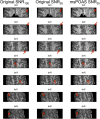High-resolution diffusion kurtosis imaging at 3T enabled by advanced post-processing
- PMID: 25620906
- PMCID: PMC4285740
- DOI: 10.3389/fnins.2014.00427
High-resolution diffusion kurtosis imaging at 3T enabled by advanced post-processing
Abstract
Diffusion Kurtosis Imaging (DKI) is more sensitive to microstructural differences and can be related to more specific micro-scale metrics (e.g., intra-axonal volume fraction) than diffusion tensor imaging (DTI), offering exceptional potential for clinical diagnosis and research into the white and gray matter. Currently DKI is acquired only at low spatial resolution (2-3 mm isotropic), because of the lower signal-to-noise ratio (SNR) and higher artifact level associated with the technically more demanding DKI. Higher spatial resolution of about 1 mm is required for the characterization of fine white matter pathways or cortical microstructure. We used restricted-field-of-view (rFoV) imaging in combination with advanced post-processing methods to enable unprecedented high-quality, high-resolution DKI (1.2 mm isotropic) on a clinical 3T scanner. Post-processing was advanced by developing a novel method for Retrospective Eddy current and Motion ArtifacT Correction in High-resolution, multi-shell diffusion data (REMATCH). Furthermore, we applied a powerful edge preserving denoising method, denoted as multi-shell orientation-position-adaptive smoothing (msPOAS). We demonstrated the feasibility of high-quality, high-resolution DKI and its potential for delineating highly myelinated fiber pathways in the motor cortex. REMATCH performs robustly even at the low SNR level of high-resolution DKI, where standard EC and motion correction failed (i.e., produced incorrectly aligned images) and thus biased the diffusion model fit. We showed that the combination of REMATCH and msPOAS increased the contrast between gray and white matter in mean kurtosis (MK) maps by about 35% and at the same time preserves the original distribution of MK values, whereas standard Gaussian smoothing strongly biases the distribution.
Keywords: DKI; DTI; adaptive smoothing; diffusion kurtosis; eddy current and motion artifacts; gray matter; high-resolution; multi-shell dMRI.
Figures












References
-
- Andersson J., Xu J., Yacoub E., Auerbach E., Moeller S., Ugurbil K. (2012). A comprehensive Gaussian Process framework for correcting distortions and movements in diffusion images, in Proceedings of the 20th Annual Meeting International Society for Magnetic Resonance in Medicine (Melbourne: ).
Grants and funding
LinkOut - more resources
Full Text Sources
Other Literature Sources

